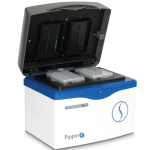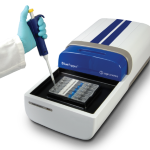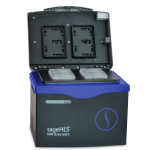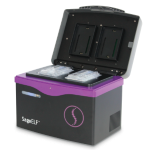Clinical and pathological heterogeneity of a congenital disorder of glycosylation manifesting as a myasthenic/myopathic syndrome
January 2014
Authors:
Dorota M. Monies, Hindi N. Al-Hindi, Mohamed A. Al-Muhaizea, Dyala J. Jaroudi, Banan Al-Younes, Ewa A. Naim, Salma M. Wakil, Brian F. Meyer, Saeed Bohlega
Info:
Collaborators at the King Faisal Specialist Hospital and the Kink Abdulaziz City for Science and Technology, Saudi Arabia, identify an homozygous mutation of ALG2 that is related to congenital muscle weakness disorders. The Pippin Prep was used in sample prep for whole exome sequencing (TargetSeq) on the Ion Torrent Proton
Citation:
Neuromuscul Disord (2014)
Epigenetic Regulation of the DLK1-MEG3 MicroRNA Cluster in Human Type 2 Diabetic Islets
January 2014
Authors:
Vasumathi Kameswaran, Nuria C. Bramswig, Lindsay B. McKenna, Melinda Penn, Jonathan Schug, Nicholas J. Hand, Ying Chen, Inchan Choi, Anastassios Vourekas, Kyoung-Jae Won, Chengyang Liu, Kumar Vivek, Ali Naji, Joshua R. Friedman, and Klaus H. Kaestner
Info:
Researchers at the University of Pennsylvania and the Children’s Hospital of Philadelphia compared small RNAs from tissue samples taken from people with and without type 2 diabetes mellitus. They found evidence that a specific cluster of microRNAs was downregulated in diabetes patients, with the promoter of that locus hypermethylated. Pippin Prep was used to size-select microRNAs for sequencing.
Citation:
Cell Metabolism (2014)
Molecular indexing enables quantitative targeted RNA sequencing and reveals poor efficiencies in standard library preparations
January 2014
Authors:
Glenn K. Fu, Weihong Xu, Julie Wilhelmy, Michael N. Mindrinos, Ronald W. Davis, Wenzhong Xiao, and Stephen P. A. Fodor
Info:
Scientists from Cellular Research and Stanford University describe a method for improving the use of RNA-seq for absolute quantification of gene expression by barcoding cDNA molecules. This molecular indexing method allowed the team to perform deep sampling and to quantify rare transcripts. Pippin Prep was used for sizing of the cDNA sample as well as for size selection in the digital PCR validation protocol.
Citation:
PNAS 2014 111 (5) 1891–1896
Variant calling in low-coverage whole genome sequencing of a Native American population sample
January 2014
Authors:
Chris Bizon, Michael Spiegel, Scott A Chasse, Ian R Gizer, Yun Li, Ewa P Malc, Piotr A Mieczkowski, Josh K Sailsbery, Xiaoshu Wang, Cindy L Ehlers and Kirk C Wilhelmsen
Info:
Scientists from the University of North Carolina at Chapel Hill tested Thunder, a linkage disequilibrium-aware variant caller, on a community sample of Native Americans and determined that low-coverage whole genome sequencing is better at finding novel variants and associations than fixed-content genotyping arrays. They used Pippin Prep to select fragments of 300 base pairs for sequencing on the HiSeq 2000.
Citation:
BMC Genomics 2014, 15:85
Transcriptome Analysis in Venom Gland of the Predatory Giant Ant Dinoponera quadriceps: Insights into the Polypeptide Toxin Arsenal of Hymenopterans
January 2014
Authors:
Alba F. C. Torres, Chen Huang, Cheong-Meng Chong, Siu Wai Leung, Alvaro R. B. Prieto-da-Silva, Alexandre Havt, Yves P. Quinet, Alice M. C. Martins, Simon M. Y. Lee, and Gandhi Radis-Baptista
Info:
Scientists from Brazil and Macao performed a transcriptome analysis of Dinoponera quadriceps, a predatory giant ant, to learn more about its venom. They found novel sequences that contribute to knowledge about the function and biological makeup of the venom’s toxins. The team used Pippin Prep to target 330 bp fragments, which were then sequenced on the Ion Torrent PGM.
Citation:
PLoS ONE 9(1): e87556. doi:10.1371/journal.pone.0087556





